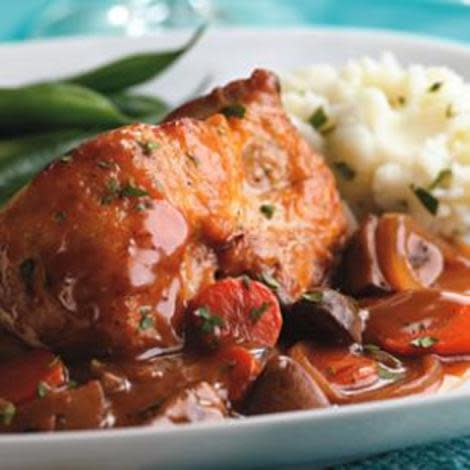Little Tricks to Save 500+ Calories at Dinner

By Hilary Meyer, Associate Food Editor, EatingWell Magazine
I enjoy food WAY too much to always be on a diet. Instead of giving my eating habits an overhaul, I'm going to make small changes to what I'm already doing when I'm cooking to save more than 500 calories. Here are 5 little tricks that save calories at dinner.
Don't Miss: 10 Cooking Tips to Make Your Favorite Foods Healthier
1. Use a Nonstick Skillet
Cooking oil does a terrific job of preventing foods from sticking to the pan. It also does a terrific job at making your pants not fit. So in order to use less of it, consider using a nonstick pan. The smooth nonporous surface makes it harder for foods to stick and burn. You only need a tablespoon of oil to brown chicken in a nonstick pan, as in our low-cal Quick Coq au Vin recipe (see below). Just one small word of caution: nonstick pans get their nonstickness from perfluorocarbons (PFCs), chemicals that are linked to liver damage and developmental problems. But who needs their liver or their brain if they look good in skinny jeans? Just kidding. You can avoid exposure to PFCs if you take care not to scratch the surface of the pan and don't use it over very high heat. Or purchase a "green" or "eco-friendly" pan that's made without PFCs.
Calorie Savings: 124 calories
Don't Miss: What Is the Best Oil for Cooking?
2. Eat More Vegetables
Before you get too excited about French fries technically being considered a "vegetable," let me clarify: adding certain vegetables to your meal can help you cut calories. I'm talking about nonstarchy veggies like leafy greens, peppers, onions, mushrooms, broccoli, etc. They add bulk to your meal without adding too many calories, such as in the Quick Chicken Coq au Vin recipe, which has mushrooms and is served with a side of green beans (see below).
You'll also get a healthy dose of fiber, which will help you feel satisfied. And don't think that adding two puny florets of broccoli to your plate will help you drop two dress sizes in a week. Be aggressive with your veggie intake. Add a lot, and subtract more calorie-dense foods. Here's a scenario: Want 2 cups of pasta? Try mixing 1 cup cooked pasta with 1 cup cooked shredded cabbage. Slather with your regular amount of sauce.
Calorie Savings: 150 calories
Don't Miss: Low-Calorie Dinners Packed with Produce
3. Measure-Don't Eyeball-When You're Cooking
When you're baking, you dutifully measure all your ingredients, but when you're cooking dinner, you take a more casual approach and the measuring equipment tends to stay in the drawer. It's like you "just know" what a tablespoon of oil looks like spread out over a 12-inch skillet. But you don't really, and that's the problem. The difference between 1 tablespoon of oil and 2 tablespoons is about 100 calories. So it would behoove you to measure it out. And while you're at it, you might as well measure what you're putting on your plate too. Ever seen what an actual "serving" of pasta is? It's about 1 cup. Pretty humbling.
Calorie Savings: 100 calories
4. Consider Soup!
Soup is one of those magical meals that deliver volume without a ton of calories. (As long as you avoid the cream-laden versions!) It's mostly water, which fills you up when you eat. And if you're depressed about shrunken portion sizes, soup can perk you up. Even a generous bowl of soup can be relatively low-cal as long as you stick to recipes that use broth, plenty of veggies and lean meats.
Calorie Savings: 115 calories
Recipes to Try: Quick Low-Calorie Soups
5. Trim the Fat from Your Meat
This may seem like a no-brainer, but there are a million ways to trim fat to slim down dinner. Or at least three ways. Choose lean cuts of meat like sirloin steak or boneless, skinless chicken breast. There may be just a little fat to trim in the first place, like in this Quick Coq au Vin recipe below. If you're cooking fattier cuts of meat like pork shoulder or bacon, it may be harder to trim all (or any) of the fat before it hits the pan. But as the fat is melting, spoon some of it out of the pan so it doesn't make it to your plate. And don't forget, skin on chicken and turkey is a big source of fat and calories, so getting rid of it before or after cooking is always a good idea.
Calorie Savings: 51 calories
Here's a quick, low-calorie dinner recipe incorporating some of these tricks to get you started. Want more ideas? Try our 5-Week 500-Calorie Dinner Diet Plan to Lose Weight.
Quick Coq au Vin
Healthy Weight | Lower Carbs | Heart Healthy
Makes 4 servings, 1/2 breast & 3/4 cup sauce each
Active time: 45 minutes | Total: 45 minutes
Cost per serving: under $2.50
Here's a quick version of Coq au Vin, a red wine-braised chicken-and-vegetable stew that usually takes the better part of an afternoon to make. Serve with herbed mashed potatoes and green beans.
1/4 cup all-purpose flour
2 bone-in chicken breasts (about 12 ounces each), skin removed, trimmed
1/2 teaspoon salt, divided
1/2 teaspoon freshly ground pepper, divided
1/4 cup water
2 tablespoons extra-virgin olive oil, divided
4 ounces mushrooms, quartered (about 1 1/2 cups)
2 large carrots, thinly sliced
1 small onion, halved and sliced
1 teaspoon crumbled dried rosemary
1 14-ounce can reduced-sodium chicken broth
1/2 cup dry red wine, preferably Zinfandel
1 tablespoon tomato paste
2 tablespoons chopped fresh parsley
1. Place flour in a shallow dish. Cut each chicken breast in half on the diagonal to get 4 portions about equal in weight. (Two will be smaller but thicker, the other two larger but thinner.) Sprinkle the chicken with 1/4 teaspoon each salt and pepper and dredge in the flour. Whisk water with 2 tablespoons of the leftover flour in a small bowl; set aside.
2. Heat 1 tablespoon oil in a large nonstick skillet over medium-high heat. Reduce heat to medium and add the chicken. Cook, turning once or twice, until lightly browned on all sides, 5 to 7 minutes total. Transfer to a plate.
3. Add the remaining 1 tablespoon oil to the pan; reduce heat to medium-low. Add mushrooms, carrots, onion and rosemary and cook, stirring occasionally, until the vegetables are softened and browned in spots, about 5 minutes. Add broth, wine, tomato paste and the remaining 1/4 teaspoon each salt and pepper. Stir until the tomato paste is dissolved. Bring to a simmer.
4. Return the chicken and any accumulated juice to the pan. Cover, reduce the heat to maintain a simmer and cook, stirring once or twice, until an instant-read thermometer inserted into the thickest part of the breast registers 165°F, 15 to 20 minutes. Transfer the chicken to a serving plate.
5. Increase the heat under the sauce to medium-high. Stir the water-flour mixture, add it to the pan and cook, stirring, until the sauce is thickened, about 1 minute. Serve the chicken with the sauce, sprinkled with parsley.
Per serving: 288 calories; 10 g fat (2 g sat, 6 g mono); 68 mg cholesterol; 14 g carbohydrate; 0 g added sugars; 28 g protein; 2 g fiber; 641 mg sodium; 623 mg potassium.
Nutrition bonus: Vitamin A (125% daily value), Potassium (19% dv).
What are you favorite cooking tricks to save calories?
By Hilary Meyer

EatingWell Associate Food Editor Hilary Meyer spends much of her time in the EatingWell Test Kitchen, testing and developing healthy recipes. She is a graduate of New England Culinary Institute.
Related Links from EatingWell:
